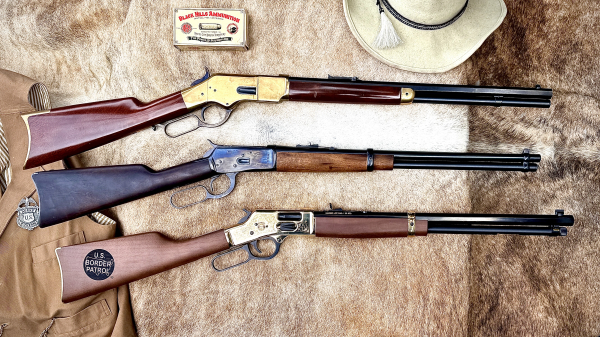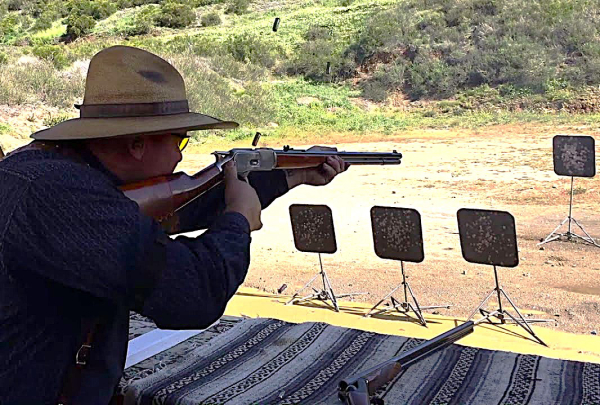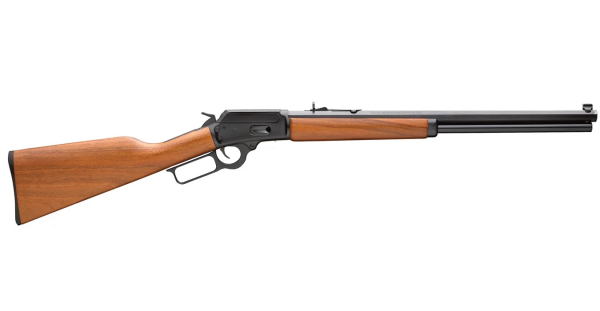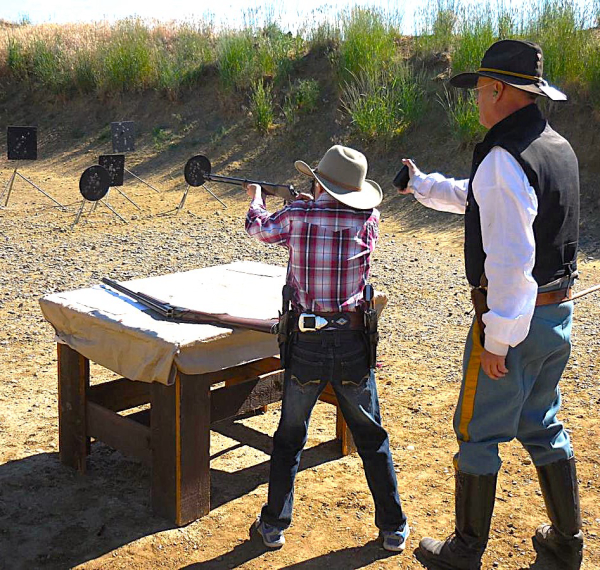By William Bell

Cowboy Action Shooting (CAS) originated in Southern California and its competitions, rules and regulations were formalized in 1987, when the Single Action Shooting Society was founded. SASS is the governing body for CAS, ensuring the safety and consistency of the sport, while preserving Old West history. In a nutshell, members dress in Old West attire, use an alias, and shoot guns that were common during the period of 1860-1899, with exceptions noted in the SASS Shooters Handbook. Basic firearms needed to compete are two single action sixguns, a period shotgun, and a lever action carbine or rifle. Competitors shoot at steel targets, so only lead bullet cartridges at moderate velocities are allowed. Main Matches have several stages, and each stage has a procedure that must be followed. These are timed events and time penalties are added for misses or failure to follow the procedure. It might sound complicated, but really, it’s not and once you go to a match you’ll most likely get hooked; at least I did!
The Lever Action Carbine or Rifle

The lever action rifle was perfected in 1860 by Tyler Henry, who invented a lever-operated repeating rifle, with a brass frame and tubular magazine, that fired self-contained metallic cartridges. The Henry cartridge was a .44 caliber rimfire that was later used in the Model 1866 Winchester, a refinement of the Henry. In 1873, Winchester introduced an iron and later steel framed lever action shooting a more powerful centerfire cartridge called the .44-40 WCF. Larger Winchester lever-guns using more powerful cartridges for use on large game were the Models 1876 and Model 1886. A scaled-down version of the Model 1886, the Model 1892 used “pistol caliber” cartridges. Other lever guns of similar operation and calibers were made by such companies as Burgess, Bullard, Kennedy, Marlin, and Whitney.
The SASS Shooters Handbook states that the CAS lever-gun used must be from the proper period and be either an original or replica (with a few exceptions) incorporating a tubular magazine, and exposed hammer. Rifles in Main Matches must be “pistol caliber,” such as .32-20,
.38 Special/.357 Magnum, .44-40 or .45 Colt among others. Larger caliber rifles, such as a Model 1886 in .45-70 are mostly used in long range side matches. The two most popular calibers these days are the .38 Spl./.357 Magnum and .45 Colt.
Choosing Your Cowboy Lever-Gun

Most CAS competitors use replicas of Old West originals. One thing to keep in mind when making a selection is magazine capacity. Main match stages require ten rounds or less; so, don’t pick a model that won’t hold 10 cartridges in the magazine. These carbines and rifles will have open iron sights. The rear sight is generally a ladder or step-adjustable semi-buckhorn type, while the front sight is a post-type with or without a gold or ivory bead. While most “cow folks” like side-gate loading lever actions, a few use the Henry replicas that are loaded near the front of the magazine tube. Here are some of the most-used reproduction lever-guns that I see during CAS main match stages.
Henry Rifle. This lever action is popular with those who shoot black powder, percussion sixguns. It has a heavy octagonal barrel, and the magazine tube is exposed as there is no wooden forend. The magazine follower has a spur that extends from a slot in the magazine tube, and it moves rearward as the lever is operated – something to be mindful of. Loading the magazine must be done carefully and the follower cannot be allowed to slam down on the cartridges after the reload. This rifle is usually chambered for the .44-40 WCF and .45 Colt cartridges.
Model 1866/Model 1873. The main difference here is the brass and steel receiver. These models are popular because their toggle-link actions allow them to be modified to use a shorter lever-stroke and thus save the real competition-minded shooter a precious second or two on their stage time. They are side-loaders and rifle versions may have an octagonal barrel, while the carbines have a round barrel. Most are chambered in the common pistol calibers.
Model 1892. Invented by John Browning, it has a scaled-down action like is found I the Model 1886. It’s popular as replicas made by Rossi, Heritage Manufacturing, and others are less expensive than the Henry or Model 1866/73. This too is a side-loader, but it’s rear-locking bolt action cannot be slicked up like the Model 66/73. I have a rifle in .357 Magnum with a 24” octagonal barrel and a round-barrel carbine in .45 Colt; these are the two most popular chamberings.
Marlin Model 1894. This lever-gun has a large following and some shooters prefer it as the empty cartridge cases are ejected out of the left side of the receiver; unlike the above-mentioned rifles that have top ejection. Their actions are not as easy to modify for speed. A few years ago, Remington took over Marlin and made Model 1894’s much like the originals. Now Ruger is making Marlin lever-guns, but the new Model 1894 is not “CAS friendly.” This means you’ll have to seek out an old-stock or used Model 1894. Most common calibers are .357 and .44 Magnum, plus .45 Colt.

Henry Repeating Arms (HRA) Big Boy. This rifle is one of the rulebook exceptions isn’t a replica of an Old West lever-gun. You can choose from a Big Boy with a brass or blue steel or color case-hardened receiver and the newer models have the much-favored side-loading feature. Older Big Boys are loaded through a slot in the magazine tube. These rifles also have side ejection, and their actions are generally smooth. Rifles and carbines come in chamberings such as .327/.32 H&R Magnum, .357 Magnum, .44 Magnum, and .45 Colt.
Lever-Guns for Little Buckeroos. CAS is a family friendly sport, and they have a shooting category for kids under 13 called Buckeroo/Buckerette. This entitles the youngster to shoot lever action rifles and carbines chambered for the .22 Long Rifle cartridge; however, the ammo must be standard velocity. There are lots of different .22 LR lever-guns to choose from. Popular models include the Henry (HRA) Classic and Golden Boy models, Browning BL22, the Heritage Settler, Chiappa LA322, and the Rossi Rio Bravo. A used Marlin Model 39 is a good-un too.

My recommendation for those interested in reenacting the Old West through CAS competition is go to a match, observe, and ask questions. Cowboy Action Shooters are some of the friendliest and most accommodating folks you’ll ever meet. They’ll gladly answer your questions, make recommendations, and at the end of the match, might even let you shoot a little. Check out the CAS organizations and look at their websites. Besides SASS, there’s the National Congress of Old West Shootists (NCOWS), but note, they are sticklers for period-correct authenticity in arms and accoutrements. I shoot both SASS and NCOWS and enjoy them both!
For more information on SASS go to www.sassnet.com and for NCOWS www.ncows.com.